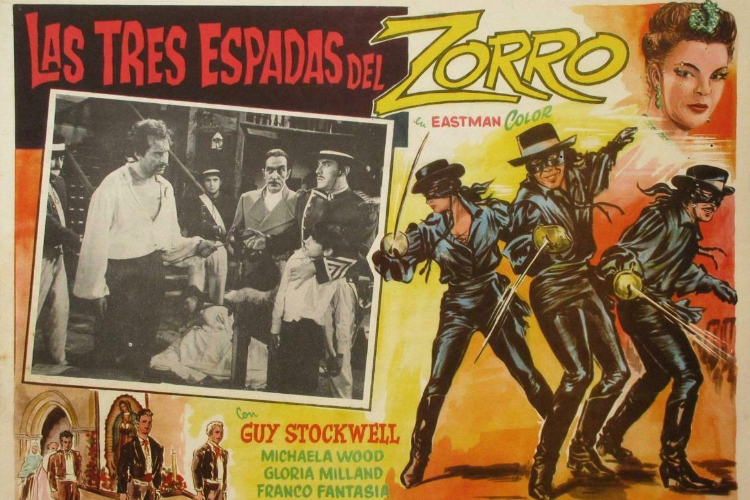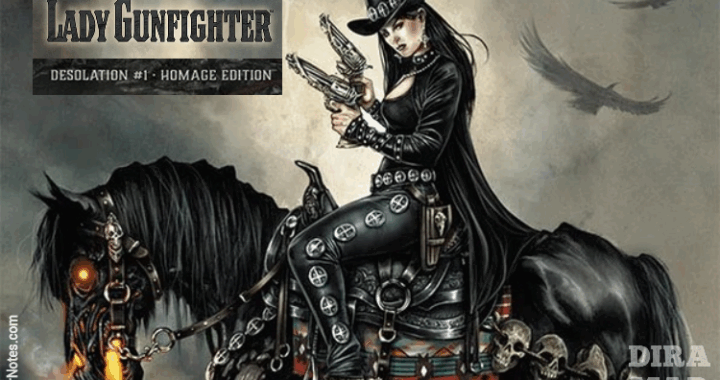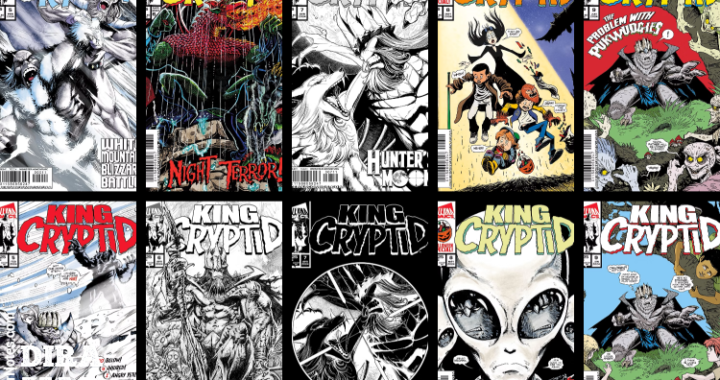
DISCOVERING LAS 3 ESPADAS DEL ZORRO
The Governor of California destroys a village where Zorro’s wife and newborn live. The child survives and is adopted by a lady who will raise him with her daughter. When he grows up, he will want to take revenge on the tyrant who destroyed his town with las 3 Espadas del Zorro.
In 1830, the year of Mexico’s independence, a group of tyrannical governors decide to impose their despotic rule over the population of recently freed citizens. Many men of honor will rise to fight these imposters, but one man will stand out among them, the man called Zorro. When Zorro’s own wife and child become targets in this struggle, the full vengeance of Zorro will be unveiled.
THE CAST
 Las 3 Espadas del Zorro also known as Sword of Zorro or The Three Swords of Zorro is a 1963 Spanish-speaking film co-produced between Spain and Italy. The film was directed by Ricardo Blasco, a Valencian director.
Las 3 Espadas del Zorro also known as Sword of Zorro or The Three Swords of Zorro is a 1963 Spanish-speaking film co-produced between Spain and Italy. The film was directed by Ricardo Blasco, a Valencian director.
The film stars Guy Stockwell as Diego, the orphaned son of the original Zorro. His dad has been in jail for the last 15 years and doesn’t know that his abandoned son has taken up the mantle of “Defender of the Oppressed”.
Gloria Milland stars as Virginia de Santa Ana, Diego’s love interest, singer Mikaela Wood plays the role of María, Diego’s stepsister, and Antonio Prieto plays the role of the ruthless Governor Manuel de Paredes. Child actor Julio César plays Diego when he was a child.
Mikaela Wood, whose career as an actress was not too long, does not hesitate to show off her talent for “copla”, a genre of Spanish popular cabaret songs from the 1890s–1910s, and, throughout the footage, offers us a double singing session with “Cielito Lindo” and “Kikiriki”, breaking the 4th wall in the process.
In the next section, I will share with you how I understood the story. Yes, there are going to be major spoilers but I think it’s important to share this perspective because sometimes things can get lost in translation or cultural differences may have an impact on how one interprets the story. I think it’s unfair when this happens with critics that are very quick to judge. Especially with foreign cinema, audiences tend to rely on critics and influencers that sometimes have their own biases or even have no idea about what they are reviewing.
Eventually, I think it’s better to watch it and make your own assessment. Sometimes rewatching is necessary. Afterward, it’s fun to compare with these “critics and influencers” and see how much they got wrong. There is always something. Now, let’s get into the story…
THE STORY
The story begins in 1830. The independence of Mexico was recently declared. Taking advantage of the initial babbling of this independence, some governors of provinces far from the capital, mocked the central power, reigning as lords of lives and estates. Some men revolted against this situation; with their courage, they forged the foundations of New Mexico. The name of one of them soon became popular in Baja California: El Zorro.
Governor Don Manuel de Paredes was the “lord of gallows and knives”. A title mostly used during the feudal time for lords who had the jurisdiction to impose capital punishments (known today as death penalties). The governor was unable to apprehend Zorro and decided to take revenge on the wife and son. He destroyed the indigenous village they lived in, not before beating her up. Before she died she ask a villager to save her newborn. The baby was left at a church and later adopted by a generous lady, a widower called Clara, who just recently had a daughter as well. The priest christened the child with the name Diego de Guadalupe which is the saint the church is devoted to.
For ten years, Don Manuel de Paredes searched for the legendary Zorro. Zorro had become his nightmare and he would not rest until he sees him hanged. We can see how the vigilante is finally captured by the governor and his soldiers, who claim the life of the lady leaving behind her two young children. Zorro was never heard from again. Ten years later, his name was just a legend jealously guarded by the oppressed peasants of Baja California.
We discover that another man, with mastery in swordsmanship and the whip, has picked up the identity of the legendary vigilante. He also uses guns when needed. His name is Don Diego de Guadalupe. He was the adopted son of the woman who was murdered the day Zorro was captured and is Zorro’s real son. However, unlike his predecessor, the new hero hides his face behind a mask and is dressed all in black. This was said 20 minutes into the film. The original Zorro was captured because he didn’t hide his identity. Among the questions I had while watching the film:
- How will one man end the tyranny that devastates Baja California with no sufficient resources and influence? His sister owns a tavern and he does voluntary work at the church. He doesn’t seem to have much wealth.
- Does he need to forge alliances?
Zorro defends the poor from the evil governor’s oppression, re-discovers his real father in jail, and frees him. Together with his step-sister and his father, they attack the Governor and his soldier during his marriage ceremony with Virginia. Government officials arrive on the scene to arrest him and his cronies. In the end, they all reveal themselves in front of the government representatives who thanked them for their service. They are acknowledged as three powerful invincible swords in service of justice. Diego is then set to marry Virginia.

A DISAPPOINTING DISCOVERY
As I mention in my previous publication “Rediscovering Zorro: The Curse of Capistrano” I am first a fan of the Disney version but I’m open to watching and reading more of Zorro. I expected to see a Zorro that is different yet similar to the 1919 version.
THE STORY
The story fails to be engaging. The circumstances are not clearly established. Why were Zorro’s wife and son living in the Indigenous Village in the first place? How did the General know they were there? Why didn’t the original Zorro have a secret identity?
THE MUSIC
The music score is annoying with all the screaming at the beginning of the film, it remains the same tone during the whole movie. We get 2 performances from singer Mikaela who plays Maria. Why break the 4th wall and not have her focus on the audience in the room instead during her performance? Also, why two songs, one is sufficient. All the while we have no clue what skills she has. She is portrayed as a regular woman but I had the impression that women during that time running a tavern did not have a good reputation.
THE COSTUME
Zorro’s costume looks cheap, especially the mask. Maybe because Diego in this version is not exactly from the wealthy class. Another detail is that there is no tornado, the beautiful black steed. However, this time we see Zorro riding on the back of a brown horse.
THE FEMALE ZORRO
The fact that Diego’s sister takes his identity as Zorro and becomes his sister at arms, along with his father, the original Zorro, by backing him up when he needs help should have been interesting but it’s not. She only does it by the end of the movie and before that, you are not told in any way of what she is capable of, because she is very skilled with the sword. You don’t see when she is given the costume or whether she will remain to help him but Diego seems to completely trust her.
They take a chunk of time from the film having her sing and dance. A shorter version of that should have been sufficient and instead maybe showcase her doing something to show her abilities. Maria other than being the eye candy and providing entertainment doesn’t do much to show her physical capabilities until the end of the movie. By then I completely lost interest and I’m bored out of my mind. Her character as another vigilante was not properly established.
I love Disney’s Zorro and learn not too long ago about Zorro’s Black Whip and Queen of Swords. This film came on my radar during discussions about Female Zorros. I’ve watched both by now and I have to say that they are way better-developed characters than Maria. Someone commented how great the old versions were and how this film had the first Female Zorro and how great she was. This person completely dismissed Zorro’s Black Whip from the 1940s and Queen of Swords from the 2000s as just characters inspired by Zorro yet not part of the original Zorro legacy. But the same can be applied to this Zorro which is completely different. I’ll say this version is one of the first female Zorro in a Movie. Black Whip and the Queen would be the first two in serial format but technically, the Black Whip was screened in theaters.
THE HUMOR
One final disappointment was the humor. Especially when Diego gets kicked in the behind which is supposed to be funny. It is reminiscent of Cantinflas. I’m having a very hard time watching Diego being treated with no dignity. I wasn’t laughing then. On the other hand, Virginia’s maids were funny at times, and not to forget young Diego’s characterization of the soldiers.
FINAL THOUGHTS
 Las 3 Espadas del Zorro is an iteration of Zorro that was inspired by the original version of 1919 by Johnston McCulley, in the same way, Zorro’s Black Whip and Queen of Swords were. However, the execution was poorly done. It was one of the many European action films shown constantly in theatres and later on American television in the early 1960s.
Las 3 Espadas del Zorro is an iteration of Zorro that was inspired by the original version of 1919 by Johnston McCulley, in the same way, Zorro’s Black Whip and Queen of Swords were. However, the execution was poorly done. It was one of the many European action films shown constantly in theatres and later on American television in the early 1960s.
Despite the effort to make it popular and relevant, the film pales in comparison to the more mainstream Zorro films and serials produced before. The portrayal of Diego, some overacting, poor choice of soundtrack, and the execution of some of the action scenes are so poorly done that it was very difficult for me to finish this film.
I can see this version of Zorro more in parallel with Robin Hood with how he wants to help the less fortunate and with Superman, in how he tries to hide his identity as Zorro by characterizing Diego de Guadalupe in a similar way as Clark Kent in order not to arouse suspicion.
It is very difficult for me to see this version of Zorro in the same light as the original Zorro who had a clear goal, defend the poor and the weak against corrupt and tyrannical government officials, and had an ethical code to live by. He couldn’t show his identity as there were always enemies around.
This Zorro lacks commitment. From the story, I can’t figure out what his motivations are besides avenging his mother’s death and I’m not convinced that he is committed to remaining as Zorro. In the end, the 3 Zorros reveal themselves after it was established by the government official that justice has arrived implying that they would be probably working for the government. Everyone now knows who they are and who they are related to so I guess they won’t have any other choice. If only they would have kept their identity a secret.
The film overall failed to keep me invested in the story. It has some entertaining parts but I did not care for Diego, Maria, or Virginia. I found Virginia’s maids to be even more entertaining than her. In summary, Guy Stockwell is not Guy Williams or Antonio Banderas. That was my experience which will probably be very different from yours.
The film is available on Amazon on DVD and can be found on Youtube.
My Rating: 6/10
Interested in more? Let’s keep an eye on Alternative Entertainment!
All images in this publication belong to the original creators and are used as references under fair use.



